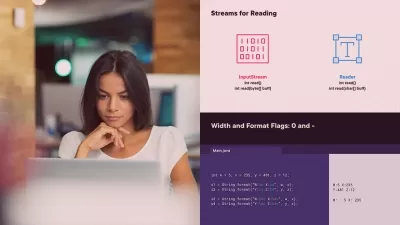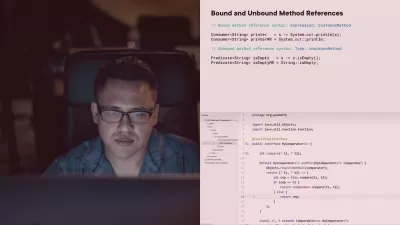The Well-Grounded Java Developer, Second Edition, Video Edition
Focused View
19:19:27
85 View
001. foreword.mp4
03:10
002. Part 1. From 8 to 11 and beyond!.mp4
01:27
003. Chapter 1. Introducing modern Java.mp4
07:42
004. Chapter 1. The new Java release model.mp4
08:20
005. Chapter 1. Enhanced type inference (var keyword).mp4
09:17
006. Chapter 1. Changing the language and the platform.mp4
09:52
007. Chapter 1. Small changes in Java 11.mp4
10:06
008. Chapter 1. HTTP2 (Java 11).mp4
09:26
009. Chapter 2. Java modules.mp4
11:24
010. Chapter 2. The module graph.mp4
08:02
011. Chapter 2. Basic modules syntax.mp4
07:41
012. Chapter 2. Loading modules.mp4
07:53
013. Chapter 2. Building a first modular app.mp4
10:19
014. Chapter 2. Architecting for modules.mp4
08:27
015. Chapter 2. Multi-release JARs.mp4
11:32
016. Chapter 3. Java 17.mp4
10:23
017. Chapter 3. Records.mp4
10:10
018. Chapter 3. Nominal typing.mp4
06:44
019. Chapter 3. Sealed Types.mp4
09:39
020. Chapter 3. New form of instanceof.mp4
08:30
021. Part 2. Under the hood.mp4
02:26
022. Chapter 4. Class files and bytecode.mp4
11:24
023. Chapter 4. Class objects.mp4
09:05
024. Chapter 4. Custom class loading.mp4
11:16
025. Chapter 4. Examining class files.mp4
08:37
026. Chapter 4. Disassembling a class.mp4
08:53
027. Chapter 4. Introduction to opcodes.mp4
06:26
028. Chapter 4. Invocation opcodes.mp4
08:18
029. Chapter 4. Reflection.mp4
10:11
030. Chapter 5. Java concurrency fundamentals.mp4
06:16
031. Chapter 5. Amdahls law.mp4
06:24
032. Chapter 5. Design concepts.mp4
08:09
033. Chapter 5. Block-structured concurrency (pre-Java 5).mp4
10:29
034. Chapter 5. Deadlocks.mp4
08:17
035. Chapter 5. Thread states and methods.mp4
11:19
036. Chapter 5. Immutability.mp4
10:26
037. Chapter 5. Understanding concurrency through bytecode.mp4
10:11
038. Chapter 5. Unsynchronized reads.mp4
10:45
039. Chapter 6. JDK concurrency libraries.mp4
10:02
040. Chapter 6. CountDownLatch.mp4
07:29
041. Chapter 6. Approaches to a concurrent Dictionary.mp4
09:37
042. Chapter 6. CopyOnWriteArrayList.mp4
11:41
043. Chapter 6. Using BlockingQueue APIs.mp4
08:17
044. Chapter 6. CompletableFuture.mp4
09:28
045. Chapter 6. Single-threaded executor.mp4
08:37
046. Chapter 7. Understanding Java performance.mp4
11:19
047. Chapter 7. A pragmatic approach to performance analysis.mp4
07:32
048. Chapter 7. Know what your performance goals are.mp4
07:06
049. Chapter 7. What went wrong Why do we have to care.mp4
08:44
050. Chapter 7. Why is Java performance tuning hard.mp4
07:35
051. Chapter 7. Garbage collection.mp4
08:18
052. Chapter 7. Young collections.mp4
08:54
053. Chapter 7. The Parallel collector.mp4
06:15
054. Chapter 7. JIT compilation with HotSpot.mp4
07:41
055. Chapter 7. Inlining methods.mp4
07:23
056. Chapter 7. JDK Flight Recorder.mp4
11:08
057. Part 3. Non-Java languages on the JVM.mp4
02:24
058. Chapter 8. Alternative JVM languages.mp4
07:02
059. Chapter 8. Imperative vs. functional languages.mp4
06:31
060. Chapter 8. Polyglot programming on the JVM.mp4
06:25
061. Chapter 8. Up-and-coming languages.mp4
07:41
062. Chapter 8. How to choose a non-Java language for your project.mp4
09:08
063. Chapter 8. How the JVM supports alternative languages.mp4
09:23
064. Chapter 9. Kotlin.mp4
07:29
065. Chapter 9. Functions.mp4
05:53
066. Chapter 9. Collections.mp4
07:26
067. Chapter 9. A different view of classes and objects.mp4
09:01
068. Chapter 9. Safety.mp4
07:06
069. Chapter 9. Concurrency.mp4
12:18
070. Chapter 10. Clojure A different view of programming.mp4
09:25
071. Chapter 10. Getting started with the REPL.mp4
09:25
072. Chapter 10. Looking for Clojure Syntax and semantics.mp4
11:12
073. Chapter 10. Arithmetic, equality, and other operations.mp4
07:35
074. Chapter 10. Loops in Clojure.mp4
06:23
075. Chapter 10. Functional programming and closures.mp4
12:23
076. Chapter 10. Interoperating between Clojure and Java.mp4
10:56
077. Chapter 10. Macros.mp4
11:51
078. Part 4. Build and deployment.mp4
01:55
079. Chapter 11. Building with Gradle and Maven.mp4
10:28
080. Chapter 11. Ensuring consistency between developers.mp4
09:48
081. Chapter 11. Controlling the manifest.mp4
06:21
082. Chapter 11. Dependency management.mp4
10:30
083. Chapter 11. Maven and modules.mp4
07:37
084. Chapter 11. Gradle.mp4
10:29
085. Chapter 11. Dependencies in Gradle.mp4
07:12
086. Chapter 11. Testing.mp4
06:24
087. Chapter 11. Using Gradle with modules.mp4
09:38
088. Chapter 12. Running Java in containers.mp4
05:34
089. Chapter 12. Host operating systems vs. virtual machines vs. containers.mp4
06:29
090. Chapter 12. Docker fundamentals.mp4
08:34
091. Chapter 12. Developing Java applications with Docker.mp4
09:06
092. Chapter 12. Ports and hosts.mp4
08:07
093. Chapter 12. Debugging in Docker.mp4
06:10
094. Chapter 12. Kubernetes.mp4
07:54
095. Chapter 12. Observability and performance.mp4
08:22
096. Chapter 12. Performance in containers.mp4
05:00
097. Chapter 13. Testing fundamentals.mp4
11:14
098. Chapter 13. Test-driven development.mp4
06:06
099. Chapter 13. A TDD example with a single use case.mp4
06:48
100. Chapter 13. Test doubles.mp4
06:34
101. Chapter 13. Fake object.mp4
09:10
102. Chapter 13. From JUnit 4 to 5.mp4
08:15
103. Chapter 14. Testing beyond JUnit.mp4
06:50
104. Chapter 14. Gathering container logs.mp4
06:38
105. Chapter 14. Specification-style testing with Spek and Kotlin.mp4
06:55
106. Chapter 14. Property-based testing with Clojure.mp4
08:29
107. Chapter 14. test.check.mp4
12:17
108. Part 5. Java frontiers.mp4
01:17
109. Chapter 15. Advanced functional programming.mp4
06:51
110. Chapter 15. Recursion.mp4
06:22
111. Chapter 15. Limitations of Java as a FP language.mp4
08:16
112. Chapter 15. Recursion.mp4
06:40
113. Chapter 15. Laziness.mp4
11:31
114. Chapter 15. Kotlin FP.mp4
11:22
115. Chapter 15. Tail recursion.mp4
07:07
116. Chapter 15. Sequences.mp4
08:54
117. Chapter 15. Lazy sequences.mp4
06:32
118. Chapter 16. Advanced concurrent programming.mp4
10:43
119. Chapter 16. Concurrency and functional programming.mp4
10:19
120. Chapter 16. Under the hood with Kotlin coroutines.mp4
10:40
121. Chapter 16. Concurrent Clojure.mp4
10:27
122. Chapter 16. Software transactional memory.mp4
09:12
123. Chapter 17. Modern internals.mp4
10:46
124. Chapter 17. Final methods.mp4
11:27
125. Chapter 17. MethodType.mp4
07:08
126. Chapter 17. Invokedynamic.mp4
10:04
127. Chapter 17. Small internal changes.mp4
09:58
128. Chapter 17. Unsafe.mp4
08:05
129. Chapter 17. Replacing Unsafe with supported APIs.mp4
09:51
130. Chapter 18. Future Java.mp4
06:05
131. Chapter 18. Project Panama.mp4
11:38
132. Chapter 18. Project Loom.mp4
09:50
133. Chapter 18. Thread builders.mp4
09:18
134. Chapter 18. Project Valhalla.mp4
08:57
135. Chapter 18. Consequences of value objects.mp4
07:42
136. Chapter 18. Generics revisited.mp4
07:23
137. Appendix A. Selecting your Java.mp4
07:09
More details
User Reviews
Rating
average 0
Focused display
Category

O'Reilly
View courses O'ReillyO'Reilly Media is an American learning company established by Tim O'Reilly that publishes books, produces tech conferences, and provides an online learning platform. Its distinctive brand features a woodcut of an animal on many of its book covers.
- language english
- Training sessions 137
- duration 19:19:27
- Release Date 2023/03/27










